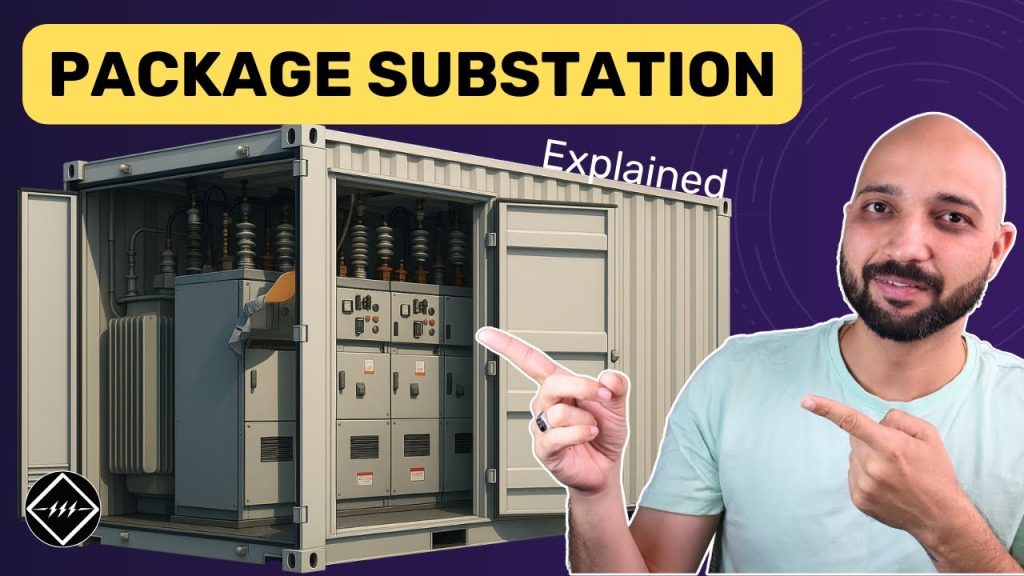
Package Substation: Everything You Need to Know
Package Substation: Everything You Need to Know https://www.theelectricalguy.in/wp-content/uploads/2025/08/maxresdefault-1-1024x576.jpg 1024 576 Gaurav Joshi Gaurav Joshi https://secure.gravatar.com/avatar/8d621b67d3005addbda23477c1259921ee1db2decf01a4f473bf0e5c76f3933a?s=96&d=mm&r=gThe electrical industry is evolving fast. To keep up, engineers now use smart, space-saving, and low-maintenance solutions. One such innovation is the package substation. It is compact, easy to install, and suitable for all weather conditions.
This article will help you understand what a package substation is, its components, how it works, and the advantages it offers. Therefore, whether you’re a beginner or a professional, you will still find this guide clear and useful.
Table of Contents
- What is a Package Substation?
- Main Components of a Package Substation
- Internal Layout and Configuration
- Working of a Package Substation
- Advantages of Package Substations
- Standards for Package Substations
- Real-World Applications
- Comparison with Conventional Substations
- Future Scope of Package Substations
- Conclusion
What is a Package Substation?
It has all the important parts in one unit. In fact, people also call it a compact substation (CSS), a metal-clad substation, or even a prefabricated substation. However, IEC standards list the correct term as a prefabricated substation. Since manufacturers assemble it at the factory, you can install it more quickly and handle it more easily than traditional designs.
This type of substation is designed to step down medium-voltage power to low-voltage levels, which can be used in homes, offices, and small industries. The key feature? Everything comes pre-installed and tested from the factory.
Main Components of a Package Substation
A typical package substation includes three main parts:
Medium Voltage Switchgear (RMU)
The incoming power first enters the ring main unit (RMU). This unit protects and controls the flow of electricity before it reaches the transformer. It often contains:
- Load break switches
- Circuit breakers
- Metering units
The RMU ensures smooth operation and adds a layer of protection to the transformer.
Transformer
This is the heart of the package substation. The transformer reduces the voltage (e.g., from 11 kV to 415 V). This lower voltage is safe for residential or commercial use.
Transformers come in different ratings based on the local power grid, usually 11 kV, 22 kV, or even 36 kV.
Low Voltage Switchgear (LT Panel)
After voltage reduction, power moves to the low voltage (LV) panel. This unit distributes the electricity to various loads. It includes:
- Air circuit breakers (ACBs)
- Molded case circuit breakers (MCCBs)
- Energy meters and other protection devices
The LV panel ensures safe and controlled distribution of electricity to the end users.
Internal Layout and Configuration
The package substation has a container-like design, and engineers place the components in different compartments inside it.
- RMU Section – The incoming medium-voltage power enters here.
- Transformer Section – Converts medium voltage to low voltage.
- LV Panel Section – Distributes power through ACBs and MCCBs.
Each compartment includes doors for easy access, and technicians can remove the top for repairs or improvements.
For safety, the enclosure includes:
- Hinged doors with padlocks
- Pressure relief flaps for explosion risks
- Dedicated bushings for neutral connections
- Lifting clamps for easy movement
Working of a Package Substation
Here’s a simple step-by-step overview of how it works:
- Power enters the RMU through a load break switch.
- It moves through a vacuum circuit breaker to the transformer.
- The transformer steps down the voltage (e.g., 11 kV to 415 V).
- Power reaches the LV panel, where ACBs and MCCBs distribute it to loads.
- Loads include buildings, homes, or machines, depending on the location.
This arrangement reduces energy loss and improves safety.
If you want to learn how to read and interpret SLDs like a pro, check out my course, Single Line Diagram Masterclass.
Advantages of Package Substations
Reduced Installation Time
The biggest benefit of a package substation is its fast installation. Since manufacturers test and assemble the machine at the factory, you only need to bring it to the site, connect the cables, and start using it. As a result, the entire process saves both time and effort, which makes it ideal for modern projects where speed is essential.
Lower Cost
Lower installation time means less labor cost. Operational cost has also been low over the years because the system needs very little maintenance. It’s a win-win for companies.
Space-Saving Design
Conventional air-insulated substations need more space. In contrast, a package substation fits into tight corners and small areas. Therefore, in cities where land is expensive, this compact design becomes a major advantage.
High Safety
All components are enclosed inside metal housings. This reduces the risk of shocks, fires, and other accidents. Built-in pressure relief flaps help release gas if anything goes wrong inside.
Low Maintenance
Most of the parts, such as the transformer, RMU, and LV panel, are sealed. As a result, this design keeps dust and water away. Consequently, the components last longer and require only basic checks.
Weather-Proof
The substation can handle rain, snow, and heat. High IP-rated panels and ventilation systems make it perfect for harsh environments.
Standards for Package Substations
The IEC 62271-202 standard applies to AC prefabricated substations rated above 1 kV and up to 52 kV. IEC refers to them as “prefabricated substations” and places them under high-voltage switchgear.
Note: IEC does not make a clear distinction between medium voltage and high voltage. This is why the same standard covers substations for 11 kV to 36 kV and above.
Real-World Applications
Package substations are used widely in:
- Urban residential colonies
- Shopping malls
- Hospitals
- Railways
- Industrial estates
- Smart cities
- Renewable energy projects
In short, anywhere power needs to be stepped down and distributed quickly and safely.
Comparison with Conventional Substations
| Feature | 24kV Package Substation | 24kV Conventional Substation |
| Installation Time | Very Low | High |
| Space Required | Compact | Large |
| Maintenance | Minimal | Frequent |
| Safety | High (enclosed) | Moderate (open design) |
| Cost | Low (overall) | High |
| Weather Resistance | Excellent (IP rated) | Moderate |
Future Scope of Package Substations
As cities grow and power demand increases, there’s more need for smart and modular systems. Package substations offer flexibility and fast deployment, making them ideal for future smart grid applications.
They can also be combined with IoT sensors to track performance and detect faults early. This helps in predictive maintenance, reducing downtimes and improving reliability.
Conclusion
A package substation is a modern, compact, and efficient solution for stepping down and distributing power. It includes all major components, RMU, transformer, and LV panel, in a safe and easy-to-install container.
Its advantages, low cost, quick installation, less space usage, and high safety, make it an excellent choice for today’s power needs.
To see the layout, compartments, and real-life visuals of a package substation, we highly recommend watching the video linked below. It will give you a clear picture of how everything works inside.

- Posted In:
- Switchgear
Gaurav Joshi
Gaurav, also known as TheElectricalGuy, is an accomplished electrical engineer with over 8 years of experience in the high and medium voltage switchgear industry. In addition to his professional endeavors, Gaurav has made significant contributions to the global electrical engineering community through his highly successful YouTube Channel. With over 195K subscribers and a prestigious silver play button from YouTube, he has become a trusted resource for electrical engineers worldwide. Gaurav's dedication to sharing knowledge extends to the creation of comprehensive courses, which have already attracted over 3000 students eager to enhance their skills in the field.
All stories by: Gaurav Joshi

